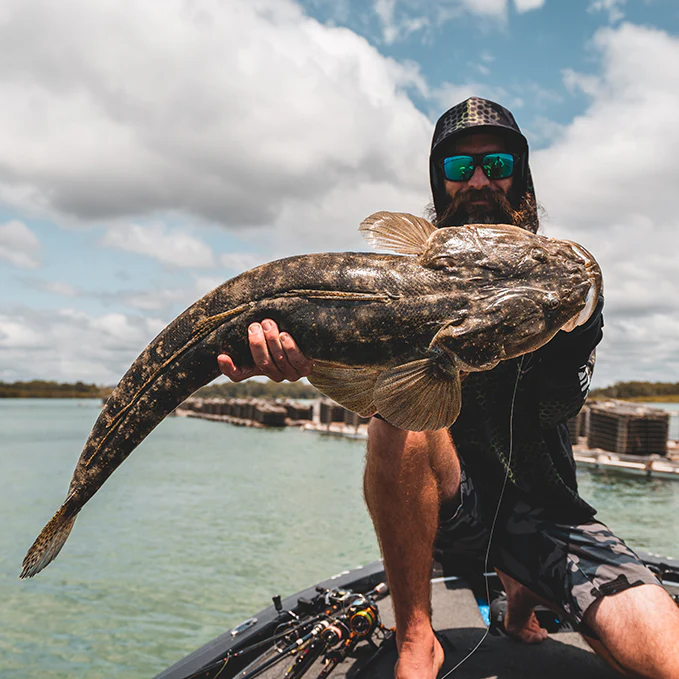Flathead (Platycephalus spp.) are one of the most sought-after fish in Australia, known for their delicious taste and availability in estuaries and shallow waters. Catching flathead can be simple, but mastering advanced techniques ensures you consistently land bigger fish. This guide dives into the expert-level strategies, gear, and seasonal tips to help you catch flathead more effectively in Australian waters.
1. Understanding Flathead Behavior and Habitat
a. Habitat
Flathead are ambush predators commonly found in sandy or muddy bottoms of estuaries, river mouths, and shallow coastal waters. They bury themselves in the substrate, waiting to strike passing prey. Key locations to target include:
•Drop-offs: Edges where shallow water transitions to deeper channels.
•Sand Flats: Particularly around seagrass beds where baitfish congregate.
•Tidal Flow Areas: Zones with moving water that bring baitfish into reach.
b. Behavior
•Flathead are opportunistic feeders, preying on small fish, prawns, and squid.
•They are most active during tidal changes, especially as water flows over sandbanks and channels.
•Larger flathead are often solitary, whereas smaller ones may be found in groups.
2. Essential Gear for Flathead Fishing
a. Rods
A lightweight spinning rod with a fast or moderate-fast action is ideal for flathead fishing.
•Length: 6’6” to 7’6”
•Power: Light to medium
•Recommended Rods:
•Favorite X1: Perfect for casting soft plastics and hardbaits with precision.
•Favorite White Bird: Great for versatile inshore fishing.
b. Reels
A 2500–3000 size spinning reel provides the balance of line capacity and smooth drag needed for flathead.
•Recommended Reels: Shimano Stradic FL, Daiwa Fuego LT.
c. Line and Leader
•Mainline: 6–10 lb braid for sensitivity and casting distance.
•Leader: 10–15 lb fluorocarbon to resist abrasion from flathead’s sharp teeth and rough habitat.
d. Terminal Tackle
•Hooks: Offset worm hooks or jigheads, depending on your lure choice.
•Weights: 1/8 to 1/2 oz jigheads for soft plastics or sliding sinkers for bait rigs.
3. Advanced Techniques for Targeting Flathead
a. Soft Plastics Fishing
Soft plastics are one of the most effective lures for flathead.
•Lures: Paddle tails (e.g., ZMan MinnowZ), curl tails (e.g., Berkley Gulp Minnow), or shrimp imitations.
•Technique: Cast ahead of your drift and allow the lure to sink to the bottom. Use a slow hop-and-pause retrieve, letting the lure mimic an injured baitfish.
•Pro Tip: Flathead often strike during the pause, so stay alert for subtle bites.
b. Trolling Hardbody Lures
Trolling is excellent for covering large areas and locating active flathead.
•Lures: Shallow-diving hardbaits (e.g., Rapala X-Rap) in natural colors like silver or green.
•Technique: Maintain a speed of 2–4 knots, ensuring the lure bumps along the bottom occasionally to attract attention.
c. Live Baiting
Live bait is unbeatable when targeting large flathead.
•Bait Options: Mullet, prawns, or pilchards.
•Rig Setup: Use a running sinker rig with enough weight to keep the bait near the bottom.
•Pro Tip: Drift your bait along drop-offs or sandbanks where flathead lie in wait.
d. Working the Drop-offs
Targeting flathead along drop-offs requires precision and patience.
•Cast soft plastics or live bait slightly upcurrent and let the bait drift naturally along the edge.
•Use your sounder to locate depth changes and structure where flathead may be hiding.
4. Seasonal Tips for Flathead Fishing
•Spring and Summer: Flathead move into shallow estuaries to feed actively. Early mornings and evenings are prime times.
•Autumn: Transition periods are excellent for targeting larger fish in deeper channels.
•Winter: Focus on deeper waters where flathead remain relatively active, especially in northern regions.
5. Common Mistakes to Avoid
a. Overworking the Lure
Flathead are ambush predators. Overly aggressive retrieves can scare them off. Opt for slow, deliberate movements.
b. Ignoring Tidal Movements
Flathead rely on tidal flows to bring baitfish to them. Plan your fishing trips around rising and falling tides for the best results.
c. Using Heavy Gear
Flathead require finesse. Heavy rods and thick lines reduce sensitivity and may decrease your chances of detecting subtle bites.
6. Why Flathead Are a Great Target for Anglers
Flathead are perfect for anglers of all skill levels. They are abundant, accessible, and offer a fun challenge with their sharp strikes and occasional acrobatics. Additionally, they are excellent eating fish, making them a rewarding catch for those who enjoy fresh seafood.
Conclusion
Catching flathead in Australian waters is a rewarding experience that combines strategy, skill, and the right gear. By understanding their behavior, targeting key habitats, and mastering advanced techniques, you’ll improve your chances of success. Whether you prefer soft plastics, live baiting, or trolling, flathead fishing offers endless opportunities for excitement.
Explore our range of spinning rods at Favorite24.au to find the perfect gear for your next fishing adventure!
